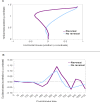Tracking second thoughts: continuous and discrete revision processes during visual lexical decision
- PMID: 25699992
- PMCID: PMC4336137
- DOI: 10.1371/journal.pone.0116193
Tracking second thoughts: continuous and discrete revision processes during visual lexical decision
Abstract
We studied the dynamics of lexical decisions by asking participants to categorize lexical and nonlexical stimuli and recording their mouse movements toward response buttons during the choice. In a previous report we revealed greater trajectory curvature and attraction to competitors for Low Frequency words and Pseudowords. This analysis did not clarify whether the trajectory curvature in the two conditions was due to a continuous dynamic competition between the response alternatives or if a discrete revision process (a "change of mind") took place during the choice from an initially selected response to the opposite one. To disentangle these two possibilities, here we analyse the velocity and acceleration profiles of mouse movements during the choice. Pseudowords' peak movement velocity occurred with 100 ms delay with respect to words and Letters Strings. Acceleration profile for High and Low Frequency words and Letters Strings exhibited a butterfly plot with one acceleration peak at 400 ms and one deceleration peak at 650 ms. Differently, Pseudowords' acceleration profile had double positive peaks (at 400 and 600 ms) followed by movement deceleration, in correspondence with changes in the decision from lexical to nonlexical response buttons. These results speak to different online processes during the categorization of Low Frequency words and Pseudowords, with a continuous competition process for the former and a discrete revision process for the latter.
Conflict of interest statement
Figures





Similar articles
-
Unfolding visual lexical decision in time.PLoS One. 2012;7(4):e35932. doi: 10.1371/journal.pone.0035932. Epub 2012 Apr 26. PLoS One. 2012. PMID: 22563419 Free PMC article.
-
The frequency effect for pseudowords in the lexical decision task.Percept Psychophys. 2005 Feb;67(2):301-14. doi: 10.3758/bf03206493. Percept Psychophys. 2005. PMID: 15971693
-
Long-lasting effects of briefly flashed words and pseudowords in ultrarapid serial visual presentation.J Exp Psychol Learn Mem Cogn. 2010 Sep;36(5):1339-45. doi: 10.1037/a0019999. J Exp Psychol Learn Mem Cogn. 2010. PMID: 20804301
-
ERP manifestations of processing printed words at different psycholinguistic levels: time course and scalp distribution.J Cogn Neurosci. 1999 May;11(3):235-60. doi: 10.1162/089892999563373. J Cogn Neurosci. 1999. PMID: 10402254
-
BALDEY: A database of auditory lexical decisions.Q J Exp Psychol (Hove). 2015;68(8):1469-88. doi: 10.1080/17470218.2014.984730. Epub 2015 Jan 27. Q J Exp Psychol (Hove). 2015. PMID: 25397865
Cited by
-
Embodied choice: how action influences perceptual decision making.PLoS Comput Biol. 2015 Apr 7;11(4):e1004110. doi: 10.1371/journal.pcbi.1004110. eCollection 2015 Apr. PLoS Comput Biol. 2015. PMID: 25849349 Free PMC article.
-
Drawing sounds: representing tones and chords spatially.Exp Brain Res. 2016 Dec;234(12):3509-3522. doi: 10.1007/s00221-016-4747-9. Epub 2016 Aug 8. Exp Brain Res. 2016. PMID: 27501731
-
Influences of First and Second Language Phonology on Spanish Children Learning to Read in English.Front Psychol. 2022 Mar 24;13:803518. doi: 10.3389/fpsyg.2022.803518. eCollection 2022. Front Psychol. 2022. PMID: 35401334 Free PMC article.
-
Decoding social decisions from movement kinematics.iScience. 2022 Nov 10;25(12):105550. doi: 10.1016/j.isci.2022.105550. eCollection 2022 Dec 22. iScience. 2022. PMID: 36444302 Free PMC article.
-
Lost to translation: How design factors of the mouse-tracking procedure impact the inference from action to cognition.Atten Percept Psychophys. 2019 Oct;81(7):2538-2557. doi: 10.3758/s13414-019-01889-z. Atten Percept Psychophys. 2019. PMID: 31691102 Free PMC article.
References
-
- Barca L, Bello A, Volterra V, Burani C (2010) Lexical-semantic reading in a shallow orthography: evidence from a girl with Williams Syndrome. Read Writ, 23: 569–588.
-
- Pagliuca G, Arduino LS, Barca L, Burani C (2008) Fully transparent orthography, yet lexical reading aloud: The lexicality effect in Italian. Lang Cogn Process, 23: 422–433.
Publication types
MeSH terms
LinkOut - more resources
Full Text Sources
Other Literature Sources

